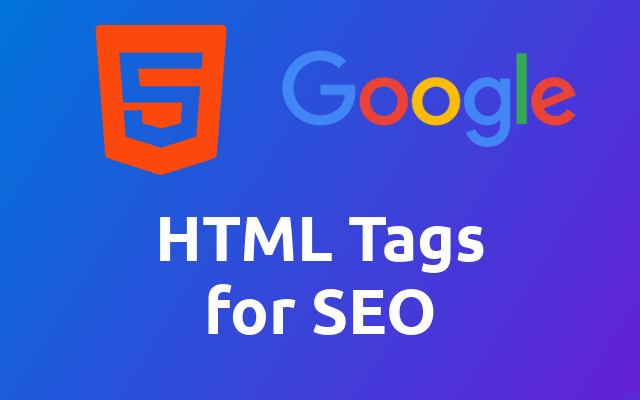HTML Tags for SEO

The most important HTML tags for SEO that you have to know.
# Page Title
As you can guess, the page title is one of the most important elements on a HTML page. All your pages should include this tag. This tag is what Google shows as title of a result per default.
<title>Page Title</title>
# Page Description
Also very important: the page description. All your pages should feature a description of their content. This is what Google as the result description per default.
<meta
name="description"
content="A description of this page.">
# Language
You have to tell Google what language you are writing in. It is good in guessing but you always communicate it explicitly just to be on the save side.
<html lang="en">
You can also get more specific, by specifying what language style you are writing in.
<html lang="en-US">
# Headings
Headings are the headlines used in your article. There are 6 levels of heading going from 1 to 6, where 1 is the most important (highest) level.
Your page should only contain one <h1> tag and this should be the first heading on your page. All others go below.
You can picture the headings of your page like a list and your first level heading as the title of the list.
Title
- h2
- h3
- h4
- h2
- h3
- h3
...
# Article Tag
Normally the scope of a page is the whole page but you can split up the content of your page into multiple content scopes using the article tag. That way you can point out to Google what the most important parts of your page are. You can do so for a whole blog post or you could use it on each element of a blog post listing.
<article>
<h1>An article on your page</h1>
<p>With some description to make it look better.</p>
</article>
<article>
<h1>Another article on your page</h1>
<p>Also with some description.</p>
</article>
# Header Tag
The header tag is a nice addition to the headings because normally head header would be considered separately but with this tag you can group other elements to form a custom header.
<article>
<header>
<h1>Headline</h1>
<h2>Subline</h2>
<p>Some more lines describing the article</p>
</header>
<p>The rest of the content ...</p>
</article>
# Title and Alt Attributes on Image Tags
Google is really good in handling text and I wouldn't say, that it can't handle images, but they are definitely another topic. So in order to make things easy for Google you should apply the title and alt attributes on the images show on your page. The alt attribute is shown to the user when the image is not loading and therefore a good indicator for Google what it is representing. The title attribute is more of a descriptive attribute where you can give some more information about the image.
<article>
<header>
<h1>Random Cats</h1>
<p>A list of random cat images.</p>
<img
src="/covers/random-cats.png"
alt="Header Image"
title="Random Cats">
</header>
<ul>
<li>
<img src="cat1.png" alt="cat 1" title="A cat in a green shirt.">
</li>
<li>
<img src="cat2.png" alt="cat 2" title="A cat waring sunglasses.">
</li>
...
# Aside
Much like pointing out the important contents of your page to Google, you can tell it what you consider not so important.
<article>
<h1>Post Title</h1>
<p>Post content to make it look nice.</p>
<aside>
Maybe some information about the author?
</aside>
</article>
# Nav
To point out navigation elements to Google you can use the nav tag. But don't wrap every link that you consider important into that! Only group real navigation links with it.
<article>
<h1>Documentation</h1>
<nav>
<ul>
<li>
<a href="#intro">Introduction</a>
</li>
<li>
<a href="#usage">Usage</a>
</li>
...
</ul>
</nav>
</article>
# Googlooo!
While writing this article I had the following video in the back of my mind. So to finish off, I thought I share it with you.
